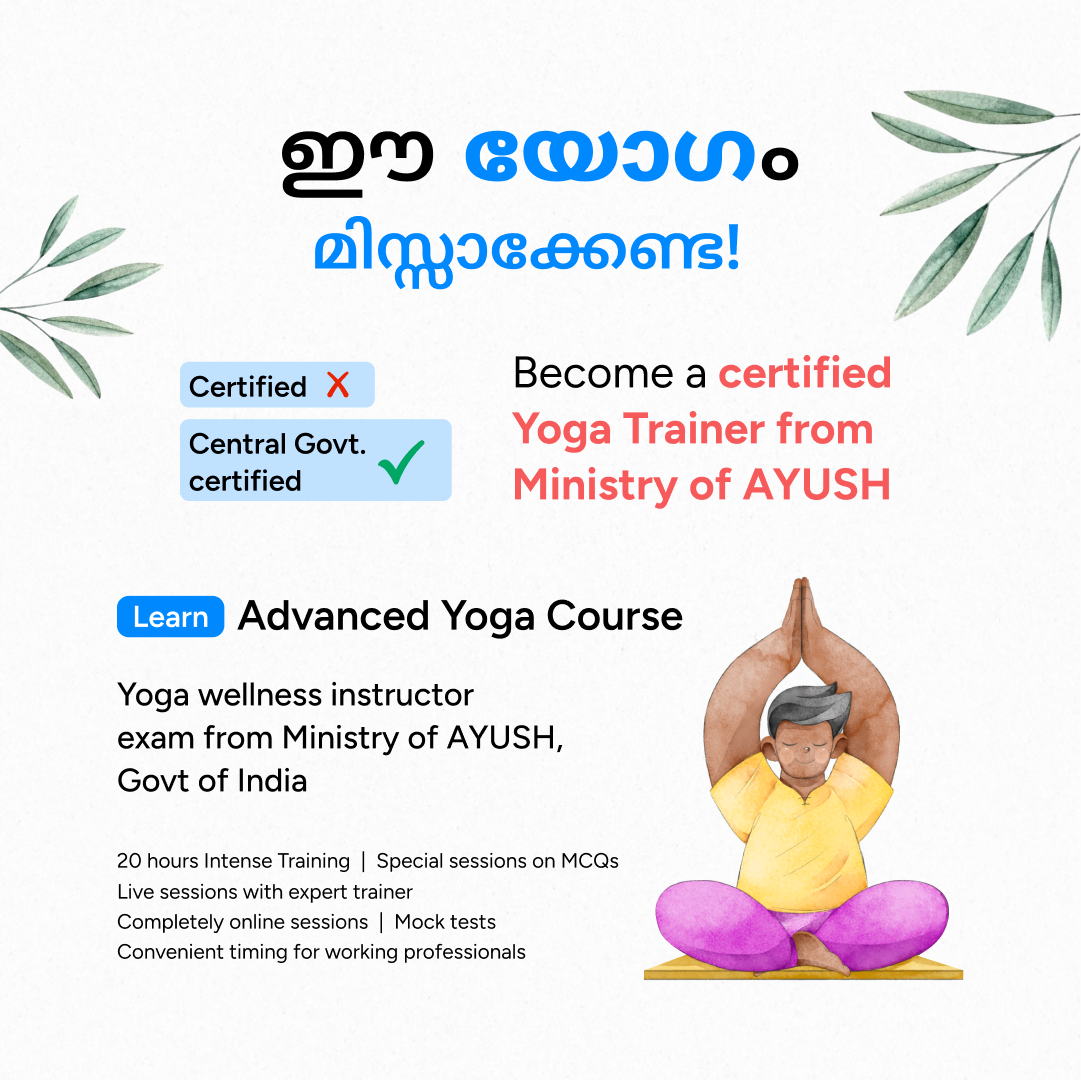Table of Contents
Living in India today feels like a race against time. Between long work hours, endless traffic, and quick meals grabbed it is no wonder we are being affected by diabetes, obesity etc.. These conditions, often called lifestyle diseases, affect millions, over 60% of Indian adults, by some estimates, and they’re hitting younger people too. I’ve seen friends in their 30s worry about blood sugar spikes or constant stress, and it’s a wake-up call. The good news? Yoga, a practice rooted in our culture, can help us take control of our health without fancy gyms or expensive treatments. Let’s explore how yoga can keep lifestyle diseases at bay and how you can start today.
Improve your life by using Yoga as preventive measure for lifestyle disease! Join Entri to learn!
What Are Lifestyle Diseases, and Why Are They a Problem?
Lifestyle diseases, or non-communicable diseases (NCDs), come from our daily habits like eating too many sweets, sitting all day, or stressing over deadlines. In India, diabetes is a massive issue, affecting around 77 million people. While heart disease kills about 1.5 million people each year. Obesity is climbing fast in cities, and high blood pressure is almost a given for many. These aren’t caused by germs but by choices we make, often without knowing it:
-
Grabbing processed snacks instead of fruits.
-
Spending hours on phones or desks instead of moving.
-
Letting work stress keep us up at night.
Treating these conditions isn’t cheap—managing diabetes can cost ₹10,000-20,000 a year, and that’s just for one person. Medicines help, but they don’t fix the root problem. That’s where yoga comes in, offering a natural way to prevent these issues before they start.
Yoga as a preventive measure for lifestyle disease is not a new concept. Yoga, a holistic art and science is the best way to live a healthy life that has ever been created and is particularly useful in treating common lifestyle conditions like diabetes and hypertension. It is a comprehensive and all-encompassing life science that addresses the mental, emotional, physical and spiritual well-being of the individual and his community. In the next sections we will learn about lifestyle disease and how to prevent it with yoga.
What does Yoga do to prevent Lifestyle Diseases?
1: Which of these is the primary goal of yoga practice?
Yoga attacks lifestyle diseases at the root. Here’s what it can do for you:
- Strengthens Your Heart: Cobra (lifting your chest while lying face down) or Bridge (lying on your back, lifting your hips) gets your blood flowing and takes pressure off your heart. Research shows yoga can reduce heart disease risk by improving cholesterol and calming your nervous system.
- Balances Blood Sugar: Stress makes diabetes worse by messing with insulin. Gentle poses like Forward Fold (bending at the hips) and deep breathing helps your body handle sugar better, keeps diabetes at bay.
- Manages Weight: Moving through Sun Salutations or holding poses like Warrior (a strong lunge) burns calories and builds muscle. Yoga makes you more aware of what you eat so you’re less likely to overdo it on snacks.
- Reduces Stress: Breathing exercises like alternate nostril breathing (Nadi Shuddhi) or meditating for 10 minutes can melt away tension. Less stress means less cortisol which protects against anxiety to high blood pressure.
- Boosts Your Defences: Relaxing poses like Corpse Pose calms your mind and strengthens your immune system, helps you fight off illnesses.
- Improves Movement and Posture: Standing poses like Mountain (standing tall, grounding your feet) or Warrior aligns your spine and strengthens your core, eases back pain and keeps you mobile.
- Supports Breathing: Breathing practices (pranayama) like humming bee breath (Bhramari) opens your lungs, makes it easier to breathe deeply and stay energized.
- Aids Digestion: Twisting poses like Half Spinal Twist presses on your belly, helps food move through and eases bloating or constipation.
Become a Certified Yoga Instructor
Yoga Teacher Training Course by Entri App: Master authentic yoga techniques, earn certification, and build a successful career as a professional yoga instructor.
Join Now!Tools of Yoga as Preventive Measure for Lifestyle Disease
Some tools in yoga that are used for the prevention of lifestyle diseases are given below.
Cultivation Of Appropriate Mindsets
The most important part of treating lifestyle diseases is to develop a positive outlook through yogic approach to all aspects of life. Stress is an internal overreaction rather than a reaction to external stimuli and can be reduced by doing this. To attain mental clarity (Chitta prasadhanam) the therapist has to give the Maharishi Patanjali values of Maitri, Karuna, Mudita, Upekshanam. Therapists should stress on cultivating Karma Yoga, Raja Yoga, Bhakti Yoga and on the patient to adopt the opposite view on negative thoughts and actions (pratipaksha bhavanam).
Breath-Body Movement Coordination Techniques
Practices that improve mind-body harmony via the use of “breath-linked movements” should be promoted. Sukshma and sheetalikarana vyayama techniques, as well as the enjoyable jathis of the Gitananda style, are beneficial in this respect. The Surya namaskar, when performed slowly with awareness of breath, can also result in psychosomatic harmony. The postures can be sustained strain-free for a brief duration while maintaining a meditative awareness of the Surya mantras, which are the names of the sun.
Healthy and Heart-friendly Diet
It is essential to have a healthy diet. Have meals regularly with green vegetable salads, sprouts, fenugreek, turmeric, bitter gourd, neem. Minimum salt and maximum potassium and calcium from fruits and low fat dairy products and good hydration is must. And therapist should tell the patient to lose few kilos of body weight to reduce blood pressure and improve insulin sensitivity. Some useful tips are to eat when hungry and after your previous meal is digested, eat small frequent meals with complex carbs, avoid processed and junk foods.
Asanas In Yoga
The following asanas may be modified to suit the patient’s physical condition and any coexisting medical issues. It is beneficial to do standing poses such as padottana, hasthapada, padangushta, mehru, and tada inversions. Bhujanga asana and Ardha Shalabha asana are beneficial standing poses, whereas vakra, gomukha, ushtra, shashaha, and yoga mudra asana are a few beneficial sitting poses. Matsya asana, pavana mukta asana, and eka and dwipada uttanpada asana are among the supine poses. The baroreceptor reflex mechanisms that control blood pressure may be reset by adopting topsy-turvy poses. If the patient is unable to do postures like sarvanga and sethubanda sarvanga asana, similar results may also be obtained using “head-below-heart” poses.
The Pranayamas
In addition to being helpful, the pranayamas of vibhaga and pranava. As well as chandra bhedana and chandra nadi lessen sympathetic overactivity. Meanwhile, these excellent methods for lowering stress include Savitri, nadi shuddhi (also known as aloma viloma in the Gitananda school), and Bhramari pranayama. Pranayamas that promote relaxation include sheetali and sitkari.
Kriyas To Remove Toxins
Cleaning techniques like kunjal, nauli, kapalabhati, agnisara, and shanka prakshalana can be done to patients based on their body inclinations.
Mudras
The shanmuki mudra, brahma mudra, and viparita karani are all beneficial in different ways. In addition to being a “head-below-heart” healer, Viparita Karani has a significant impact on the psycho-neuro-endocrine axis. While the Brahma mudra works with breath and vibration (nada) to promote a sensation of relaxation and reinvigoration in the head and neck area, reducing tension and normalizing reflex systems, the shanmuki mudra creates inner peace.
Learn Yoga as preventive measure for lifestyle disease! Join the Entri app!
Yoga Relaxation
Hatha Yoga has relaxation techniques. These can be done from shavasana. They include kaya kriya, which is dynamic body relaxation. Marmanasthanam kriya is part-by-part relaxation. Spandha nishpandha kriya alternates tension and relaxation. Thus Jnana yoga relaxation techniques like yoga nidra and anuloma viloma kriya can aid in lowering stress. And promoting psychosomatic harmony. For those suffering from any kind of psychosomatic condition, even the most basic version of the Makara asana is a great way to relieve tension.
The Dharana and the Dhyana
Popular concentration exercises that lead to a state of meditation are om japa and ajapa japa. Mandala dharana can be done on all chakras. Focus on the Anahata chakra. This balances prana vayu in the heart. Also, focus on the navel center. This harmonizes samana vayu at the manipura chakra. Chakra dhyana is another good technique.
Yogic Counselling
Since yoga is essentially a preventative life science, this is an essential part of Yoga Chikitsa for treating any lifestyle disorder (heyam dukhkam anagatham – Yoga Darshan II: 16). Counselling is not a single event. It’s a continuous process. It starts with the first appointment. It then continues through each session, at different levels.
Learn Yoga from the best teachers in the industry! Join the Entri app!
Take the First Step Today
I’ve seen yoga make a difference in my life, less stress, better sleep, and more energy to enjoy the day. In a world where lifestyle diseases are sneaking up on us, yoga is like a shield, helping you stay healthy without breaking the bank. Whether you’re dealing with long hours at a desk or just want to feel better, a few minutes of yoga can change everything.
Become a Certified Yoga Instructor
Yoga Teacher Training Course by Entri App: Master authentic yoga techniques, earn certification, and build a successful career as a professional yoga instructor.
Join Now!Frequently Asked Questions
Where can I study yoga?
Start your yoga experience by enrolling in nearby studios, taking online courses, or using instructional DVDs.
Which form of yoga is ideal for beginners?
Hatha yoga is frequently recommended for beginners because of its gentle pace and emphasis on foundational poses.
Can yoga fully substitute medical therapy for lifestyle diseases?
While yoga has several advantages, it is essential to consult with medical specialists for a full treatment plan. Yoga can supplement medicinal therapies, but it should not replace them completely.
How often should I do yoga for noticeable results?
Consistency is essential. Begin with a few sessions each week and progressively increase the frequency to see obvious effects over time.
I am not flexible. Can I still practice yoga?
Absolutely. Yoga focuses on growth rather than perfection. Flexibility may be improved over time and via practice. Modify postures to fit your current ability.


























